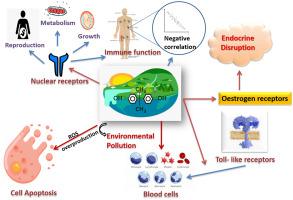Environmental Pollution ( IF 7.6 ) Pub Date : 2022-09-29 , DOI: 10.1016/j.envpol.2022.120319 Navish Kataria, Divya Bhushan, Renuka Gupta, Saravanan Rajendran, Michelle Yee Mun Teo, Kuan Shiong Khoo

|
Bisphenol-A (BPA) is a type of endocrine disrupting compound (EDC) that is being widely used in the production of polycarbonate and epoxy resins. In the last few years, human exposure to BPA has been extensively high due to the continuous increment in the Annual Growth Rate (AGR) of the BPA global market. The presence and transportation of BPA in the environment could cause serious damage to aquatic life and human health. This paper reviewed the literature on the exposure and toxicity mechanisms of BPA and advanced analytical techniques for the detection of BPA in the environment and human beings. The study indicated that BPA can cause damaging effects on numerous tissues and organs, including the reproductive system, metabolic dysfunction, respiratory system, immune system and central nervous system. On the basis of reported studies on animals, it appears that the exposure of BPA can be carcinogenic and responsible for causing a variety of cancers like ovarian cancer, uterine cancer, prostate cancer, testicular cancer, and liver cancer. This review paper focused mainly on the current progress in BPA removal technologies within last ten years (2012–2022). This paper presents a comprehensive overview of individual removal technologies, including adsorption, photocatalysis/photodegradation, ozonation/advance oxidation, photo-fenton, membranes/nanofilters, and biodegradation, along with removal mechanisms. The extensive literature study shows that each technology has its own removal mechanism and their respective limitations in BPA treatment. In adsorption and membrane separation process, most of BPA has been treated by electrostatic interaction, hydrogen boning and π-π interations mechanism. Whereas in the degradation mechanism, O* and OH* species have played a major role in BPA removal. Some factors could alter the removal potential and efficiency of BPA removal. This review paper will provide a useful guide in providing directions for future investigation to address the problem of BPA-containing wastewater treatment.
中文翻译:

水环境中塑料废物(双酚A)处理技术的当前进展:发生、毒性和修复机制
双酚 A (BPA) 是一种内分泌干扰化合物 (EDC),广泛用于生产聚碳酸酯和环氧树脂。在过去的几年里,由于 BPA 全球市场的年增长率 (AGR) 不断增加,人类对 BPA 的接触率一直很高。BPA 在环境中的存在和运输可能对水生生物和人类健康造成严重损害。本文回顾了有关 BPA 暴露和毒性机制的文献,以及用于检测环境和人类中 BPA 的先进分析技术。研究表明,双酚A可对多种组织和器官造成破坏性影响,包括生殖系统、代谢功能障碍、呼吸系统、免疫系统和中枢神经系统。根据已报道的动物研究,BPA 的暴露似乎会致癌,并导致多种癌症,如卵巢癌、子宫癌、前列腺癌、睾丸癌和肝癌。本综述主要关注过去十年(2012-2022 年)中 BPA 去除技术的当前进展。本文全面概述了各种去除技术,包括吸附、光催化/光降解、臭氧化/高级氧化、光芬顿、膜/纳米过滤器和生物降解,以及去除机制。广泛的文献研究表明,每种技术都有其自身的去除机制和各自在 BPA 处理中的局限性。在吸附和膜分离过程中,大部分 BPA 都经过静电相互作用处理,氢键和π-π相互作用机制。而在降解机制中,O* 和 OH* 物质在 BPA 去除中起主要作用。一些因素可能会改变 BPA 去除的潜力和效率。这篇综述论文将为未来研究解决含 BPA 废水处理问题提供方向提供有用的指导。











































 京公网安备 11010802027423号
京公网安备 11010802027423号